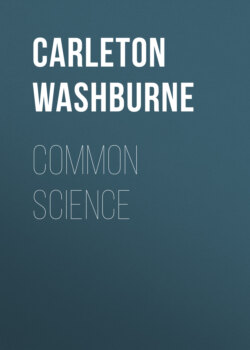Читать книгу Common Science - Carleton Washburne - Страница 34
На сайте Литреса книга снята с продажи.
Fig. 22. El Capitan, Yosemite Valley, California. If the force of cohesion were suspended, a mountain like this would immediately become the finest dust.
ОглавлениеTable of Contents
Things happen too swiftly for you to know much about them. The house you are in falls to dust instantly. You fall through the place where the floor has been; but you do not bump on the cement basement floor below, partly because there is no such thing as a hard floor or even hard ground anywhere, and partly because you disintegrate—fall to pieces—so completely that there is nothing left of you but a grayish film of fine dust and a haze of warm water.
With a deafening roar, rocks, skyscrapers, and even mountains tumble down, fall to pieces, and sink into an inconceivably fine dust. Nothing stands up in the world—not a tree, not an animal, not an island. With a wild rush the oceans flood in over the dust that has been nations and continents, and then this dust turns to a fine muddy ooze in the bottom of a worldwide sea.
But it is an ocean utterly different from what we have in the real world. There are no waves. Neither are there any reflections of clouds in its surface—first because the clouds would fly to pieces and turn to invisible vapor, and second, because the ocean has no surface—it simply melts away into the air and no one can tell where the water stops and where the air begins.
Then the earth grows larger and larger. The ocean turns to a heavy, dense, transparent steam. The fine mud that used to be rocks and mountains and living things turns to a heavy, dense gas.
Our once beautiful, solid, warm, living earth now whirls on through space, a swollen, gaseous globe, utterly dead.
And the only thing that prevents all this from actually happening right now is that there is a force called cohesion that holds things together. It is the pull which one particle of anything has on another particle of the same material. The paper in this book, the chair on which you are sitting, and you yourself are all made of a vast number of unthinkably small particles called molecules, each of which is pulling on its neighbor with such force that all stay in their places. Substances in which they pull the hardest, like steel, are very hard to break in two; that is, it is difficult to pull the molecules of these substances apart. In liquids, such as water, the molecules do not pull nearly so hard on each other. In a gas, such as air, they are so far apart that they have practically no pull on each other at all. That is why everything would turn to a gas if the force of cohesion stopped. Why things would turn cold will be explained in Chapter 4.
Cohesion, adhesion, and capillary attraction, all are the result of the pull of molecules on each other. The difference is that capillary attraction is the pulling of particles of liquids up into fine spaces, as when a lamp wick draws up oil; adhesion is the pull of the particles of one substance or thing on the particles of another when they are very close together, as when water clings to your hand or when dust sticks to the ceiling; while cohesion is the clinging together of the particles of the same substance, like the holding together of the particles of your chair or of this paper.
When you put your hand into water it gets wet because the adhesion of the water to your hand is stronger than the cohesion of the water itself. The particles of the water are drawn to your hand more powerfully than they are drawn to each other. But in the following experiment, you have an example of cases where cohesion is stronger than adhesion:
Experiment 16. Pour some mercury (quicksilver) into a small dish and dip your finger into it. As you raise your finger, see if the mercury follows it up as the water did in Experiment 14. When you pull your finger all the way out, has the mercury wet it at all? Put a lamp wick or a part of your handkerchief into the mercury. Does it draw the mercury up as it would draw up water?
